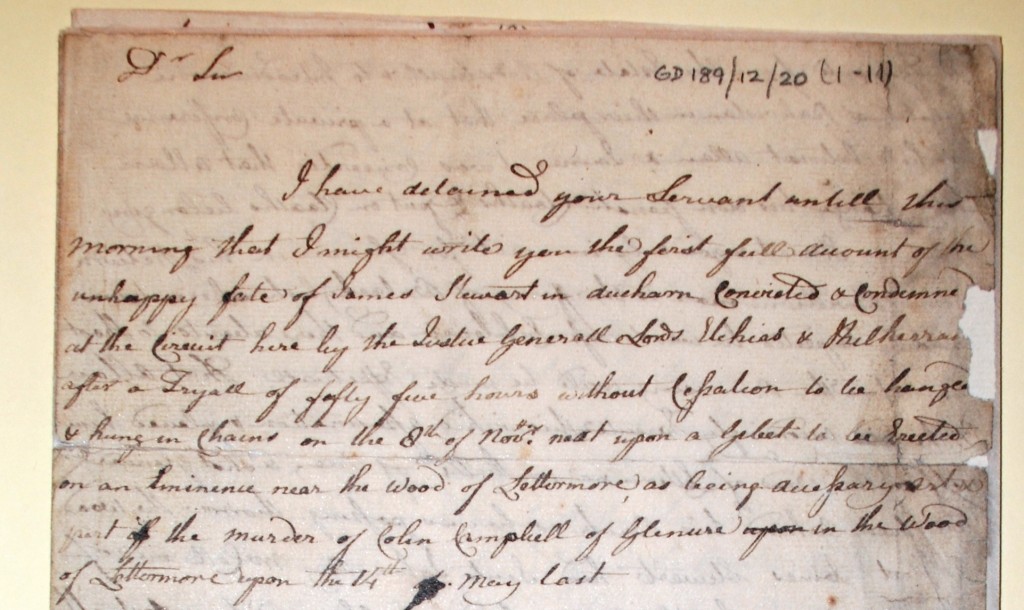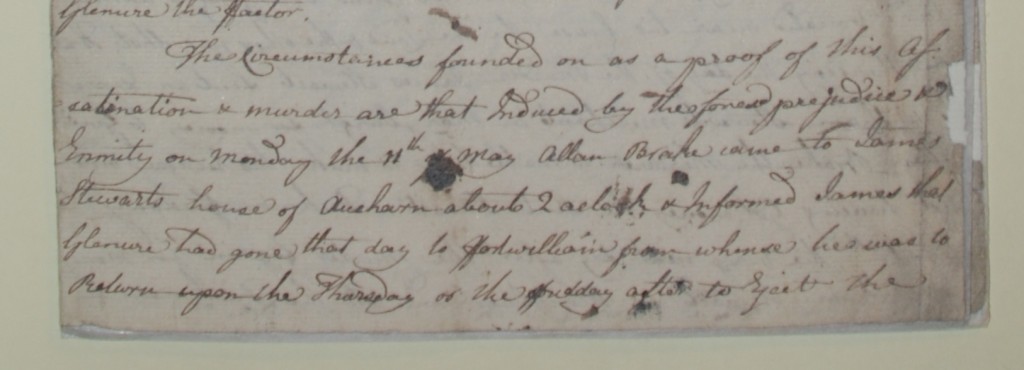Who killed Red Fox? The Appin Murder remains one of Scotland’s greatest unsolved mysteries. Colin Roy Campbell of Glenure, Argyllshire, also known as The Red Fox, was shot on 14 May 1752 whilst riding near Lettermore Wood. Two days later, James Stewart, known as James of the Glen, was arrested and accused of his murder. The trial that ensued would be one of Scotland’s most controversial miscarriages of justice.
Within the Murray of Polmaise collection here at Stirling Council Archives, there is a letter from an unsigned individual concerning the trial of James Stewart. The letter has been endorsed to be from Alexander Stewart of Edinglassie, Writer, to Mr Stewart of Appin. The letter describes ‘the unhappy fate of James Stewart’.

In his letter, Alexander Stewart explains the circumstances under which James Stewart found himself at the centre of the crime. Colin Roy Campbell had been made a Factor over certain estates in Appin which had been surrendered by Jacobite Clans. Campbell had been given the challenging task of collecting taxes from these estates. This included the land of the Jacobite Stewarts. In May 1752, Campbell had been charged to evict the Stewarts from their land and replace them with the Campbells. The chief suspect, Allan Breck Stewart, had previously confronted Colin Roy Campbell.
Allan Breck Stewart, however, had fled from the area and James Stewart was arrested as an accessory to the murder. Alexander Stewart states that ‘These are the Grounds given for the prejudices alledged conceived by James Stewart against Glenure which is pretended to have Induced him to Enter into a Combination with one Allan Brake Stewart a Remote Relation to Ardsheall to Assasinate & murder Glenure the factor’.
Alexander Stewart of Edinglassie had agreed to act as James Stewart’s agent for the trial. Before the trial started, Alexander Stewart would face many hardships in trying to craft a solid defence. He was refused access to his client and changes made to the date and time of the trial ensured that he was largely unprepared when the day arrived.
The fate of James Stewart was effectively sealed when Stewart was taken to Inveraray Castle, a Campbell stronghold, for his trial. The presiding judge was the Clan Chief of the Campbells, the Duke of Argyll. Moreover, 11 of the 15 jurors were Campbells.
The letter records the various statements of evidence given to prove James of the Glen was guilty. Two guns belonging to James were ‘found Concealed near his house the one load and the other new shot’. It was also alleged that he ‘showed not the least Surprise or Concern’ at the death of Campbell.

James Stewart had also aided Allan Breck Stewart in many ways. It was claimed he had ‘sent an Express to William Stewart Merchant in Maryburgh for money to Give Allan Brake the Murderer to Enable him to make his Escape’. The letter continues to record each piece of evidence that was proved correct. To emphasise the unfairness of that was currently occurring, Alexander Stewart writes ‘I think I have only forgot one Circumstance that was distinctly proven, that when Glenures Servant Acquainted James Stewart of his masters murder James & all his family Expressed the greatest Surprise or Concern’.
James Stewart was found guilty and sentenced to death by hanging. Alexander Stewart states that just before his execution, James of the Glen announced ‘I Doe Declare in the presence of almighty God that I had no previous knowledge of the Murder of Colin Campbell of Glenure Severall of the Witnesses have Deponed untruths against me I forgive them as I doe the Jury who have brought me in upon such Slender Evidence and I tamely Submitt to my Sentence’. James Stewart was hanged and his body was left for 18 months on an elevated gibbet near the ferry crossing as a message to passing Jacobites.